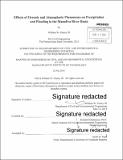| dc.contributor.advisor | Richard Schuhmann. | en_US |
| dc.contributor.author | Finney, William W., III (William Warner) | en_US |
| dc.contributor.other | Massachusetts Institute of Technology. Department of Civil and Environmental Engineering. | en_US |
| dc.coverage.spatial | f-ug--- | en_US |
| dc.date.accessioned | 2014-09-19T21:34:32Z | |
| dc.date.available | 2014-09-19T21:34:32Z | |
| dc.date.copyright | 2014 | en_US |
| dc.date.issued | 2014 | en_US |
| dc.identifier.uri | http://hdl.handle.net/1721.1/90015 | |
| dc.description | Thesis: M. Eng., Massachusetts Institute of Technology, Department of Civil and Environmental Engineering, 2014. | en_US |
| dc.description | Cataloged from PDF version of thesis. | en_US |
| dc.description | Includes bibliographical references (pages 121-126). | en_US |
| dc.description.abstract | An investigation was performed to determine the relationship between certain oceanic and atmospheric phenomena and the precipitation patterns in the Manafwa River Basin of eastern Uganda. Such phenomena are the El Niño Southern Oscillation (ENSO) and the Indian Ocean Dipole (IOD). The indices that describe ENSO and IOD are measurements of sea surface pressure and sea surface temperature conditions of the Pacific and Indian Oceans. This study compares the historical precipitation of the Manafwa River Basin with the corresponding values for the Southern Oscillation Index (SOI), Oceanic Niño Index (ONI), and Dipole Mode Index (DMI). This investigation shows a correlation between the magnitude of such indices, and the total monthly and seasonal precipitation and the occurrence of heavy precipitation events. The strongest signal detected was a positive correlation between precipitation from December to February and the Oceanic Nifio Index (ONI) of preceding seasons. A delay in precipitation response was observed from the measured climate indices. This precipitation delay indicates that current index conditions can be monitored to assess the nature of future precipitation. Additional correlations between precipitation and climate indices were identified for many of the remaining months. The characteristics of precipitation in the Manafwa River Basin during consecutive seasons of ENSO phases were also explored. It was discovered that, on average, consecutive El Niño seasons are associated with a trend of increasing amplitude of seasonal precipitation. Conversely, consecutive La Niño seasons are associated with a trend of decreasing amplitude of seasonal precipitation. The investigation was expanded to Houston, Texas and the Bou Regreg Watershed in northern Morocco to inquire if a similar response could be detected in other areas of the world. The results of this expanded study generally support the proposition that, on average, consecutive ENSO seasons are associated with trends of precipitation amplification or reduction. Although individual ENSO events do not always behave with the same precipitation patterns shown by the averages, there is value in understanding the average long-term seasonal effects of El Niño and La Niño events on watersheds. Applications of this study include, but are not limited to: reservoir and water management, flood prediction, and agricultural planning. | en_US |
| dc.description.statementofresponsibility | by William W. Finney III. | en_US |
| dc.format.extent | 144 pages | en_US |
| dc.language.iso | eng | en_US |
| dc.publisher | Massachusetts Institute of Technology | en_US |
| dc.rights | M.I.T. theses are protected by copyright. They may be viewed from this source for any purpose, but reproduction or distribution in any format is prohibited without written permission. See provided URL for inquiries about permission. | en_US |
| dc.rights.uri | http://dspace.mit.edu/handle/1721.1/7582 | en_US |
| dc.subject | Civil and Environmental Engineering. | en_US |
| dc.title | Effects of oceanic and atmospheric phenomena on precipitation and flooding in the Manafwa River Basin | en_US |
| dc.type | Thesis | en_US |
| dc.description.degree | M. Eng. | en_US |
| dc.contributor.department | Massachusetts Institute of Technology. Department of Civil and Environmental Engineering | |
| dc.identifier.oclc | 890134380 | en_US |
